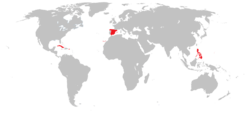First Spanish Republic
| Republic of Spain | ||||||||||
| República de España | ||||||||||
|
||||||||||
|
||||||||||
|
Motto Plus Ultra "Further Beyond" |
||||||||||
|
Anthem Himno de Riego "Anthem of Riego" |
||||||||||
| Capital | Madrid | |||||||||
| Languages | Spanish | |||||||||
| Religion | Roman Catholic | |||||||||
| Government | Republic | |||||||||
| President | ||||||||||
| • | 1873 | Estanislao Figueras | ||||||||
| • | 1873 | Francisco Pi y Margall | ||||||||
| • | 1873 | Nicolás Salmerón | ||||||||
| • | 1873–1874 | Emilio Castelar | ||||||||
| • | 1874 | Francisco Serrano | ||||||||
| Prime Minister | ||||||||||
| • | 1874 | Juan de Zavala | ||||||||
| • | 1874 | P. Mateo Sagasta | ||||||||
| Legislature | Congress of Deputies | |||||||||
| History | ||||||||||
| • | Amadeo I abdicates | 11 February 1873 | ||||||||
| • | Cantonal Revolution | 12 July 1873 | ||||||||
| • | Monarchy restored | 29 December 1874 | ||||||||
| Currency | Spanish peseta | |||||||||
|
||||||||||
The First Spanish Republic (Spanish: Primera República Española) was the short-lived political regime that existed in Spain between the parliamentary proclamation on 11 February 1873 and 29 December 1874 when General Arsenio Martínez-Campos's pronunciamento marked the beginning of the Bourbon Restoration in Spain. The Republic's founding started with the abdication as King on 10 February 1873 of Amadeo I, following the Hidalgo Affair, when he had been required by the radical government to sign a decree against the artillery officers. The next day, 11 February the republic was declared by a parliamentary majority made up of radicals, republicans and democrats.
The Constituent Cortes was called upon to write a federal constitution. The radicals preferred a unitary republic, with a much lesser role for the provinces, and once the republic had been declared the two parties turned against each other. Initially, the radicals were largely driven from power, joining those who had already been driven out by the revolution of 1868 or by the Carlist War.
The first republican attempt in the history of Spain was a short experience, characterized by profound political and social instability and violence. The Republic was governed by four distinct presidents—Estanislao Figueras, Pi i Margall, Nicolás Salmerón, Emilio Castelar; then, only eleven months after its proclamation, General Manuel Pavía led a coup d'état and established a unified republic dominated by Francisco Serrano.
...
Wikipedia



